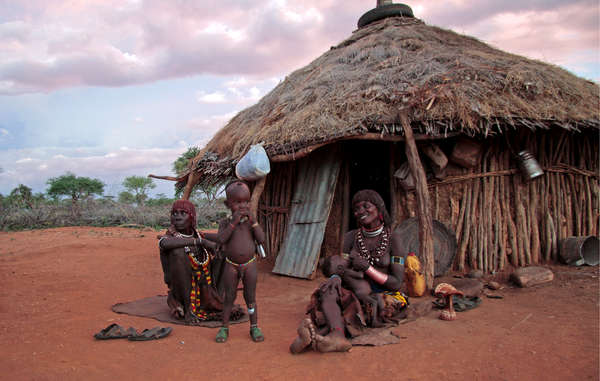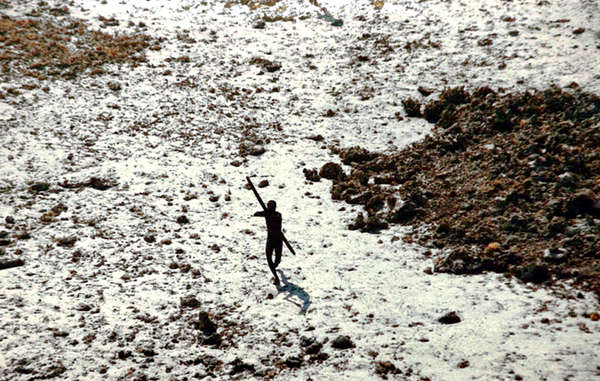Reports surface of 'massacre' of Hamar tribespeople in Ethiopia - News from Survival
- Details
- Published on Friday, 05 June 2015 04:15
- Written by editor

Reports surface of 'massacre' of Hamar tribespeople in Ethiopia
 Hamar family outside their home in Ethiopia's Lower Omo Valley© Magda Rakita/Survival
Hamar family outside their home in Ethiopia's Lower Omo Valley© Magda Rakita/Survival
Survival International has received reports that violent conflict between Ethiopian soldiers and Hamar pastoralists has left dozens dead.
The Hamar, like the other tribes of the Lower Omo Valley, are victims of the government’s policy of “villagization.”
They are being evicted to roadside villages without their consent, and their ancestral grazing lands are being sold off to investors for commercial plantations.
These land grabs have already led to starvation in some parts of the Lower Omo Valley.
Tensions have been rising as a result of these evictions and, at the end of May, Hamar were reportedly attacked by soldiers with mortars and semi-automatic weapons.
A news blackout imposed by the government makes it impossible to know the exact number of casualties, but one expert has referred to what took place as a “massacre.”
 Hamar children, Omo Valley© Survival
Hamar children, Omo Valley© Survival
Some observers have also linked the violence to the failure of the government to investigate the alleged rape of Hamar girls by local government officials, and to the prosecution of Hamar men for hunting on their ancestral homelands.
For several years, evictions have been accompanied by other serious human rights abuses in the Lower Omo Valley, including beatings, rape and arbitrary arrest.
One Hamar refugee told Survival, “The government told us that if we don’t give into them we will be slaughtered in public like goats.”
In response to Survival’s campaign, international donors to Ethiopia visited the region in August 2014. However, they have yet to release the reports from their investigation, despite formal requests by Survival to the European Union and the UK and US governments to do so.
Reports indicate that the soldiers are still in the Lower Omo and are now threatening the Mursi and Bodi, the Hamar’s neighbors, with violence. According to one indigenous person currently in the region, “They say they will kill us. We are now crying a lot. Crying to ourselves.”
Read this online: http://www.survivalinternational.org/news/10802
Survival International attacks Science editorial as 'dangerous and misleading'
 Anthropologists have been attacked for endorsing contact with highly vulnerable uncontacted tribes, which they deem 'not viable in the long term.'© G. Miranda/FUNAI/Survival
Anthropologists have been attacked for endorsing contact with highly vulnerable uncontacted tribes, which they deem 'not viable in the long term.'© G. Miranda/FUNAI/Survival
An editorial in Science magazine which calls for isolated tribes to be contacted for their own benefit has been slated as “dangerous and misleading” by Survival International, the global movement for tribal peoples’ rights.
The authors, Professors Robert S. Walker and Kim R. Hill, maintain that “a well-designed contact can be quite safe,” but the examples of contact they choose to illustrate their point were in fact catastrophic, and left many of the tribespeople dead.
The idea that contact with such tribes will end happily as long as there are adequate safeguards is dangerously naive. Brazil has more expertise in this area than any other country, yet right now two recently contacted Awá women are critically ill with tuberculosis because they were left for months without proper healthcare after contact occurred.
 Jakarewyj and her sister Amakaria were forced to make contact with outsiders in December 2014. They are now critically ill with tuberculosis due to the failure of the Brazilian authorities to provide adequate healthcare.© Survival International
Jakarewyj and her sister Amakaria were forced to make contact with outsiders in December 2014. They are now critically ill with tuberculosis due to the failure of the Brazilian authorities to provide adequate healthcare.© Survival International
Walker and Hill have also decided that isolated populations are "not viable in the long term.” At the same time, they acknowledge that there are about 50 such peoples in South America (in fact, there are more). Quite how these peoples aren’t “viable” isn’t explained, as many of them appear to be thriving.
The anthropologists’ statement would certainly come as news to perhaps the most isolated tribe in the world, the Sentinelese of the Indian Ocean, who have lived on their island for at least 15,000 years, and are visibly both “viable” and healthy.
 From what can be seen from a distance, the Sentinelese islanders are clearly extremely healthy and thriving, in marked contrast to the Great Andamanese tribes, on nearby islands, to whom the British attempted to bring ‘civilization.’© Indian Coastguard/Survival
From what can be seen from a distance, the Sentinelese islanders are clearly extremely healthy and thriving, in marked contrast to the Great Andamanese tribes, on nearby islands, to whom the British attempted to bring ‘civilization.’© Indian Coastguard/Survival
Survival’s Director Stephen Corry said today, “Walker and Hill play straight into the hands of those who want to open Amazonia up for resource extraction and ‘investment.’ That they claim this is for tribes’ own benefit is dangerous and misleading nonsense.
“Perhaps their most offensive justification for forcibly contacting isolated tribes is that ‘surviving indigenous populations rebound quickly from population crashes.’ The casual tone with which the authors dismiss the deaths of scores of men, women and children is deeply disturbing.
“Let there be no doubt: isolated tribes are perfectly viable, as long as their lands are protected. To think we have the right to invade their territories and make contact with them, whether they want it or not, with all the likely consequences, is pernicious and arrogant. The decision as to whether to make contact or not has to be one for the people themselves, not for outsiders who think they know what’s in the Indians’ best interests.”
A Guajajara Indian man fighting to protect the territory of his neighbors the Awá said: “It is simple: the uncontacted Awá need their forest. This is their home and nobody has the right to take it away from them, or to remove them from it. Without their land, our uncontacted relatives will not survive.”
And Wamaxua, a recently contacted Awá man, told Survival: “When I lived in the forest, I had a good life. Now, if I meet one of the uncontacted Awá in the forest, I’ll say: ‘Don’t leave! Stay in the forest… There’s nothing in the outside for you.’”
Notes to editors:
- Watch videos and read more about uncontacted tribes on Survival’s dedicated website www.uncontactedtribes.org
Read this online: http://www.survivalinternational.org/news/10800
Survival reveals top tribal conservation skills for Environment Day
 Awá man making arrows, Brazil. The Awá have an intimate knowledge of their rainforest and are extremely skilled hunters. © Survival International
Awá man making arrows, Brazil. The Awá have an intimate knowledge of their rainforest and are extremely skilled hunters. © Survival International
In celebration of Environment Day on Friday, June 5, Survival showcases tribal peoples’ fascinating conservation skills and intimate knowledge of their environments.
- Awá Indians in Brazil’s north-eastern Amazon rainforest know at least 275 useful plants, and at least 31 species of honey-producing bee. Each bee type is associated with another rainforest animal like the tortoise or the tapir. Read more.
- Baka “Pygmies” of Central Africa eat 14 kinds of wild honey and more than 10 types of wild yam. By leaving part of the root intact in the soil, the Baka spread pockets of wild yams – a favorite food of elephants and wild boar – throughout the forest. Read more.
 A Bushman mother and child gathering berries in the Central Kalahari Game Reserve.© Philippe Clotuche/Survival
A Bushman mother and child gathering berries in the Central Kalahari Game Reserve.© Philippe Clotuche/Survival
- The Bushmen consume over 150 species of plant and their diet is high in vitamins and nutrients. Yet Africa’s last hunting Bushmen in Botswana are abused, tortured and arrested when found hunting to feed their families. Read more.
- Baiga in India have set up their own project to “save the forest from the forest department” – setting out rules for their own community and outsiders to protect the forest and its biodiversity. As a result, the availability of water supply has increased and they have been able to collect more herbs and medicines from the forest. Read more.
 A Baiga woman overlooking her tribe's forest. Thousands of Baiga have been evicted from their land in the name of tiger 'conservation.'© Harshit Charles/ Survival
A Baiga woman overlooking her tribe's forest. Thousands of Baiga have been evicted from their land in the name of tiger 'conservation.'© Harshit Charles/ Survival
There are many more examples of how tribal peoples are the best conservationists and guardians of the natural world – satellite images and academic studies have shown that indigenous peoples provide a vital barrier to deforestation of their lands. Yet tribal peoples are being illegally evicted from their ancestral homelands in the name of “conservation.” It’s often wrongly claimed that their lands are wildernesses even though tribal peoples have been dependent on, and managed, them for millennia.
Survival’s Director Stephen Corry said today, “Tribal peoples are better at looking after their environments than anyone else – after all, they have been dependent on, and managed, them for millennia. If conservation is actually going to start working, conservationists need to ask tribal peoples what help they need to protect their land, listen to them, and then be prepared to back them up as much as possible. A major change in thinking about conservation is now urgently required.”
Notes to editors:
- View a photo gallery of tribal conservation skills.
- Environmentalists, academics, indigenous organizations and thousands of Survival supporters have called for a new approach to conservation, one that respects tribal peoples’ rights.
Read this online: http://www.survivalinternational.org/news/10794
You’re receiving...
 Monthly highlights
Monthly highlights
 Urgent campaigns
Urgent campaigns
 News as it happens
acclaimed roundup of the month's top stories
important alerts so you can take action
frequent updates
News as it happens
acclaimed roundup of the month's top stories
important alerts so you can take action
frequent updates
 Annual reports
Annual reports
 Shopping
our yearly review and special appeals
special offers from our range of cards and gifts
Shopping
our yearly review and special appeals
special offers from our range of cards and gifts
r7.
Survival International USA, 2325 3rd Street, Suite 401, San Francisco, CA 94107, USA
T +1 415 503 1254
Survival International, 6 Charterhouse Buildings, London EC1M 7ET, UK
T +44(0)20 7687 8700
www.survivalinternational.org


